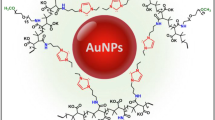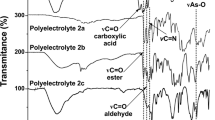Abstract
Stabilization of metallic nanoparticles in colloidal solutions has been realized by different capping agents. Heterocyclic compounds can interact with metallic surfaces, and some authors have reported the use of heterocyclic compounds for the stabilization of colloidal nanoparticles. In this work, we report stabilization of Au and Ag nanoparticles using polymers and hexa-substituted compounds with 1,3,4-oxadiazole pendant groups. Using a polyelectrolyte with 2-amino-1,3,4-oxadiazole groups was possible to reduce Au3+ and Ag+ ions and stabilize Au and Ag nanoparticles in colloidal solution. With polymers and hexa-substituted compounds containing 1,3,4-oxadiazoles substituted with methyl, phenyl, or acetyl groups, stabilize Au and Ag nanoparticles in a water-DMF medium was possible. Characterization by TEM revealed the obtaining of Au and Ag nanoparticles with control over the size and the shape. The lowest average size for Au and Ag nanoparticles was 4 and 10 nm, respectively, using the hexa-substituted compound with 2-acetamido-4-acetyl-1H-1,3,4-oxadiazole groups.









Similar content being viewed by others
References
Patel KD, Prajapati SM, Panchal SN, Patel HD (2014) Review of synthesis of 1,3,4-oxadiazole derivatives. Synth Commun 44:1859–1875. https://doi.org/10.1080/00397911.2013.879901
Yang NC, Park YH, Suh DH (2003) Synthesis and properties of new ultraviolet–blue-emissive fluorene-based aromatic polyoxadiazoles with confinement moieties. J Polym Sci A 41:674–683. https://doi.org/10.1002/pola.10616
Gomes D, Roeder J, Ponce ML, Nunes SP (2008) Single-step synthesis of sulfonated polyoxadiazoles and their use as proton conducting membranes. J Power Sources 175:49–59. https://doi.org/10.1016/j.jpowsour.2007.09.090
Dong YB, Sun T, Ma JP, Zhao XX, Huang RQ (2006) Ag(I) and Cu(II) discrete and polymeric complexes based on single- and double-armed oxadiazole-bridging organic clips. Inorg Chem 45:10613–10628. https://doi.org/10.1021/ic0612552
Singh NK, Bharty MK, Dulare R, Butcher RJ (2009) Synthesis and X-ray crystallographic studies of Ni (II) and Cu (II) complexes of [5-(4-pyridyl)-1,3,4] oxadiazole-2-thione/thiol formed by transformation of N-(pyridine-4-carbonyl)-hydrazine carbodithioate in the presence of ethylenediamine. Polyhedron 28:2443–2449. https://doi.org/10.1016/j.poly.2009.04.030
Chen L, Yang C, Li M, Qin J, Gao J, You H, Ma D (2007) Supramolecular architectures, photophysics, and electroluminescence of 1,3,4-oxadiazole-based iridium(III) complexes: from μ-dichloro bridged dimer to mononuclear complexes. Cryst Growth Des 7:39–46. https://doi.org/10.1021/cg060323s
Zhang SZ, Zhang ZH, Li CP, Du M (2009) Novel HgII and MnII supramolecular complexes with a versatile building block 5-(4-pyridyl)-1,3,4-oxadiazole-2-thiolate involving in situ ligand formation. Inorg Chem Commun 12:1038–1041. https://doi.org/10.1016/j.inoche.2009.08.015
Zhang J, Zhou L, Al-Attar HA, Shao K, Wang L, Zhu D, Su Z, Bryce MR, Monkman AP (2013) Efficient light-emitting electrochemical cells (LECs) based on ionic iridium(III) complexes with 1,3,4-oxadiazole ligands. Adv Funct Mater 23:4667–4677. https://doi.org/10.1002/adfm.201300344
Zheng Y, Batsanov AS, Bryce MR (2011) Unusual dinuclear and mononuclear cyclometalated iridium complexes of 2,5-diaryl-1,3,4-oxadiazole derivatives. Inorg Chem 50:3354–3362. https://doi.org/10.1021/ic102153x
Wu X, Liu Y, Wang Y, Wang L, Tan H, Zhu M, Zhu W, Cao Y (2012) Highly efficient near-infrared emission from binuclear cyclo-metalated platinum complexes bridged with 5-(4-octyloxyphenyl)-1,3,4-oxadiazole-2-thiol in PLEDs. Org Electron 13:932–937. https://doi.org/10.1016/j.orgel.2012.02.004
Bharty MK, Dani RK, Nath P, Bharti A, Singh NK, Prakash O, Singh RK, Butcher RJ (2015) Syntheses, structural and thermal studies on Zn(II) complexes of 5-aryl-1,3,4-oxadiazole-2-thione and dithiocarbamates: antibacterial activity and DFT calculations. Polyhedron 98:84–95. https://doi.org/10.1016/j.poly.2015.05.045
Bouklah M, Hammouti B, Lagrenee M, Bentiss F (2006) Thermodynamic properties of 2,5-bis(4-methoxyphenyl)-1,3,4-oxadiazole as a corrosion inhibitor for mild steel in normal sulfuric acid medium. Corros Sci 48:2831–2842. https://doi.org/10.1016/j.corsci.2005.08.019
Bentiss F, Traisnel M, Chaibi N, Mernari B, Vezin H, Lagrenée M (2002) 2,5-Bis(n-methoxyphenyl)-1,3,4-oxadiazoles used as corrosion inhibitors in acidic media: correlation between inhibition efficiency and chemical structure. Corros Sci 44:2271–2289. https://doi.org/10.1016/S0010-938X(02)00037-9
Lagrenée M, Mernari B, Chaibi N, Traisnel M, Vezin H, Bentiss F (2001) Investigation of the inhibitive effect of substituted oxadiazoles on the corrosion of mild steel in HCl medium. Corros Sci 43:951–962. https://doi.org/10.1016/S0010-938X(00)00076-7
Outirite M, Lagrenée M, Lebrini M, Traisnel M, Jama C, Vezin H, Bentiss F (2010) AC impedance, X-ray photoelectron spectroscopy and density functional theory studies of 3,5-bis(n-pyridyl)-1,2,4-oxadiazoles as efficient corrosion inhibitors for carbon steel surface in hydrochloric acid solution. Electrochim Acta 55:1670–1681. https://doi.org/10.1016/j.electacta.2009.10.048
Bentiss F, Lagrenée M, Traisnel M (2000) 2,5-Bis(n-Pyridyl)-1,3,4-oxadiazoles as corrosion inhibitors for mild steel in acidic media. Corrosion 56:733–742. https://doi.org/10.5006/1.3280577
Mihai M, Damaceanu MD, Aflori M, Schwarz S (2012) Calcium carbonate microparticles growth templated by an oxadiazole-functionalized maleic anhydride-co-N-vinyl-pyrrolidone copolymer, with enhanced pH stability and variable loading capabilities. Crys Growth Des 12:4479–4486. https://doi.org/10.1021/cg301011c
Chrissanthopoulos A, Tzanetos NP, Andreopoulou AK, Kallitsis J, Dalas E (2005) Calcite crystallization on oxadiazole-terpyridine copolymer. J Cryst Growth 280:594–601. https://doi.org/10.1016/j.jcrysgro.2005.02.074
Damaceanu MD, Mihai M, Popescu I, Bruma M, Schwarz S (2012) Synthesis and characterization of a new oxadiazole-functionalized maleic anhydride-N-vinylpyrrolidone copolymer and its application in CaCO3 based microparticles. React Funct Polym 72:635–641. https://doi.org/10.1016/j.reactfunctpolym.2012.06.001
Chen J, Javaheri H, Sulaiman BAC, Dahman (2016) Synthesis, characterization and applications of nanoparticles. In: Grumezescu AM (ed) Fabrication and self-assembly of nanobiomaterials1st edn. William Andrew Publishing, Ciudad Juárez, US, pp 1–27. https://doi.org/10.1016/B978-0-323-41533-0.00001-5
Herizchi R, Abbasi E, Milani M, Akbarzadeh A (2016) Current methods for synthesis of gold nanoparticles. Artif Cells Nanomed Biotechnol 44(2):596–602. https://doi.org/10.3109/21691401.2014.971807
Caldera-Villalobos M, Herrera-González AM, García-Serrano J, Martins-Alho MA, Montalvo-Sierra MI (2016) Polyelectrolytes with tetrazole pendant groups useful in the stabilization of Au and Ag nanoparticles. J Appl Polym Sci 133(43773). https://doi.org/10.1002/app.43773
Herrera-González AM, Caldera-Villalobos M, García-Serrano J, Peláez Cid AA (2016) Polyelectrolytes with sulfonic acid groups useful in the synthesis and stabilization of Au and Ag nanoparticles. Des Monomer Polym 19:330–339. https://doi.org/10.1080/15685551.2016.1152543
Niu P, Kang J, Tian X, Song L, Liu H, Wu J, Yu W, Chang J (2014) Synthesis of 2-amino-1,3,4-oxadiazoles and 2-amino-1,3,4-thiadiazoles via sequential condensation and I2-mediated oxidative C–O/C–S bond formation. J Organomet Chem 80:1018–1024. https://doi.org/10.1021/jo502518c
Herrera-González AM, García-Serrano J, Caldera-Villalobos M (2018) Synthesis and stabilization of Au nanoparticles in colloidal solution using macroelectrolytes with sulfonic acid groups. J Appl Polym Sci 135:46424. https://doi.org/10.1002/app.45888
Herrera-González AM, Caldera-Villalobos M, Bocardo-Tovar PB, García-Serrano J (2018) Synthesis of gold colloids using polyelectrolytes and macroelectrolytes containing arsonic moieties. Colloid Polym Sci 296:961–969. https://doi.org/10.1007/s00396-018-4309-8
Carriedo GA, Fernández-Catuxo L, García-Alonso FJ, Gómez-Elipe P, González PA, Sánchez G (1996) On the synthesis of functionalized cyclic and polymeric aryloxyphosphazenes from phenols. J Appl Polym Sci 59:1879–1885. https://doi.org/10.1002/(SICI)1097-4628(19960321)59:12<1879::AID-APP9>3.0.CO;2-N
Ilgin P, Ozay O, Ozay H (2019) A novel hydrogel containing thioether group as selective support material for preparation of gold nanoparticles: synthesis and catalytic applications. Appl Catal B Environ 241:415–423 [1]
Hu D, Shi Y, Du Y, Yu W, Huang J, Gao H, Zhu M (2018) Template synthesis of gold nanoparticles from hyperstar polymers and exploration of their catalytic function for hydrogen evolution reaction. Polymer 153:331–337. https://doi.org/10.1016/j.polymer.2018.08.030 [3]
Anung P, Enny L, Dede K, Mujinah, Nur SU, Hardi GA, Sarah A, Abdul M (2018). pH effect of gold nanoparticles synthesis encapsulation in polyamide amine generation 3.0 (AuNP-PAMAM G3.0) Res J Chem Environ, 22: 214–219. [4]
Pelin JN, Gatto E, Venanzi M, Cavalieri F, Oliveira CL, Martinho H, Silva ER, Aguilar AM, Souza JS Alves WA (2018) Hybrid conjugates formed between gold nanoparticles and an amyloidogenic diphenylalanine-cysteine peptide. ChemistrySelect 3(24):6756–6765 [5]
Kabomo TM, Scurrell MS (2016) The effect of protonation and oxidation state of polyaniline on the stability of gold nanoparticles. Eur Polym J 82:300–306. https://doi.org/10.1016/j.eurpolymj.2016.04.004 [6]
Zhai C, Liu X, Chen X, Li L, Sun F, Ma H (2015) Facile synthesis of intelligent polymers modified gold nanoparticles in aqueous solution. J Inorg Organomet Polym Mater 25(4):687–693. https://doi.org/10.1007/s10904-014-0146-5 [7]
Dai Y, Li Y, Wang S (2015) ABC triblock copolymer-stabilized gold nanoparticles for catalytic reduction of 4-nitrophenol. J Catal 329:425–430. https://doi.org/10.1016/j.jcat.2015.06.006 [8]
Liu X, Li L, Ye M, Xue Y, Chen S (2014) Polyaniline: poly (sodium 4-styrenesulfonate)-stabilized gold nanoparticles as efficient, versatile catalysts. Nanoscale 6(10):5223–5229. https://doi.org/10.1039/C4NR00328D [9]
Zhang H, Li W, Gu Y, Zhang S (2014) Preparation and catalytic activity of poly (N-vinyl-2-pyrrolidone)-protected Au nanoparticles for the aerobic oxidation of glucose. J Nanosci Nanotechnol 14(8):5743–5751. https://doi.org/10.1166/jnn.2014.8839 [10]
Liu Y, Mu S, Liu X, Ling Q, Hang C, Ruiz J, Astruc D, Gu H (2018) Ferrocenyl Janus mixed-dendron stars and their stabilization of Au and Ag nanoparticles. Tetrahedron 74(37):4777–4789 [2]
Vu XH, Duong TTT, Pham TTH, Trinh DK, Nguyen XH, Dang VS (2018) Synthesis and study of silver nanoparticles for antibacterial activity against Escherichia coli and Staphylococcus aureus. Adv Nat Sci Nanosci Nanotechnol 9(2):025019. https://doi.org/10.1088/2043-6254/aac58f [11]
Farooqi ZH, Khalid R, Begum R, Farooq U, Wu Q, Wu W, Ajmal M, Irfan A, Naseem K (2018) Facile synthesis of silver nanoparticles in a crosslinked polymeric system by in situ reduction method for catalytic reduction of 4-nitroaniline. Environ Technol:1–10. https://doi.org/10.1080/09593330.2018.1435737 [12]
Fahmy A, Eisa WH, Yosef M, Hassan A (2016) Ultra-thin films of poly (acrylic acid)/silver nanocomposite coatings for antimicrobial applications. J Spectroscopy 1:11. https://doi.org/10.1155/2016/7489536 [13]
Shkilnyy A, Soucé M, Dubois P, Warmont F, Saboungi ML, Chourpa I (2009) Poly (ethylene glycol)-stabilized silver nanoparticles for bioanalytical applications of SERS spectroscopy. Analyst 134(9):1868–1872. https://doi.org/10.1039/B905694G [14]
Wang H, Qiao X, Chen J, Ding S (2005) Preparation of silver nanoparticles by chemical reduction method. Colloids Surf A Physicochem Eng Asp 256(2–3):111–115. https://doi.org/10.1016/j.colsurfa.2004.12.058 [15]
Bajpai, S. K., Chand, N., & Mahendra, M. (2013). In situ formation of silver nanoparticles in poly (methacrylic acid) hydrogel for antibacterial applications. Polym Eng Sci, 53(8), 1751–1759. https://doi.org/10.1002/pen.23424[16]
De Oliveira CS, Lira BF, Barbosa-Filho JM, Lorenzo JGF, de Athayde-Filho PF (2012) Synthetic approaches and pharmacological activity of 1, 3, 4-oxadiazoles: a review of the literature from 2000–2012. Molecules 17(9):10192–10231. https://doi.org/10.3390/molecules170910192
Gong X, Zhang H, Jiang N, Wang L, Wang G (2019) Oxadiazole-based ‘on-off’fluorescence chemosensor for rapid recognition and detection of Fe2+ and Fe3+ in aqueous solution and in living cells. Microchem J 145:435–443. https://doi.org/10.1016/j.microc.2018.11.011
Lin L, Wang D, Chen SH, Wang DJ, Yin GD (2017) A highly sensitive fluorescent chemosensor for selective detection of zinc (II) ion based on the oxadiazole derivative. Spectrochim Acta A Mol Biomol Spectrosc 174:272–278. https://doi.org/10.1016/j.saa.2016.11.053
Author information
Authors and Affiliations
Corresponding author
Ethics declarations
Conflict of interest
The authors declare that they have no conflict of interest.
Additional information
Publisher’s note
Springer Nature remains neutral with regard to jurisdictional claims in published maps and institutional affiliations.
Electronic supplementary material
ESM 1
(DOCX 1733 kb)
Rights and permissions
About this article
Cite this article
Caldera-Villalobos, M., Martins-Alho, M., Herrera González, A.M. et al. Stabilization of colloidal metallic nanoparticles using polymers and hexa-substituted compounds with 1,3,4-oxadiazole pendant groups. Colloid Polym Sci 297, 933–946 (2019). https://doi.org/10.1007/s00396-019-04516-3
Received:
Revised:
Accepted:
Published:
Issue Date:
DOI: https://doi.org/10.1007/s00396-019-04516-3




